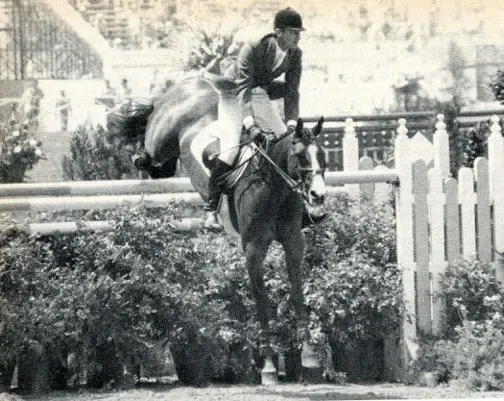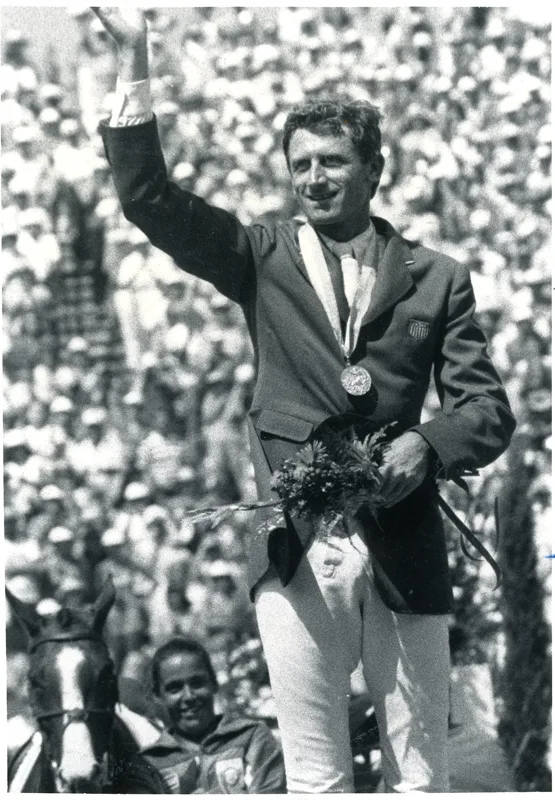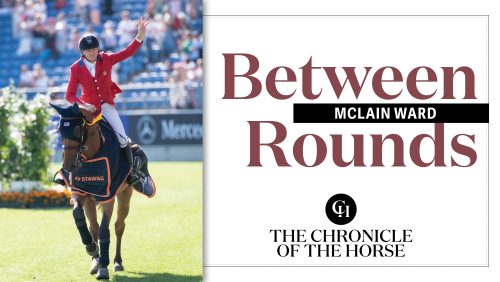In honor of the postponed 2020 Tokyo Olympics, we’re looking back at the greatest moments in equestrian Olympic history. The 1984 Olympic Games, held at the Santa Anita racetrack for a full house in Los Angeles, were an incredible highlight for U.S. horse sport, with the U.S. show jumping squad earning its first team gold medal. This excitement was topped only four days later by an American duel for individual gold between Joe Fargis on Touch Of Class and Conrad Homfeld on Abdullah. Read snippets of John Strassburger’s Chronicle report from August 17, 1984, and listen to video commentary from the legendary Bill Steinkraus to relive the glory.
Hollywood scriptwriters probably wouldn’t write a script describing what really took place on Tuesday, August 7 and Sunday, August 12, only a half hour’s drive from Tinseltown. In fact, producers would probably say it was too good to be true.
Picture this: The fledgling United States Equestrian Team, struggling to replace the Army teams, imports a man named Bertalan de Némethy in 1952 to build a show jumping team. He gathers around him a group of talented and ambitious young men and women and trains them in a classical style, teaching them the fundamentals of horsemanship they will one day pass on to countless students. De Némethy takes his prodigies to the international shows in Europe and wins, to the Pan-Am Games and wins. He takes them to the Olympics seven times and comes close to winning twice (in ’60 and ’72), but the gold eludes them.
Cut to 1980: De Némethy retires as coach. The U.S. is now among the best teams in the world, and his influence is felt throughout the country. Soon two of his stars, Frank Chapot and Chrys Jones, take over his former tasks—Chapot as team coach and Jones as team manager.
Cut to 1984: The Olympics return to the United States for the first time in 52 years. De Némethy is the course designer. Jones is the manager. Chapot is the coach, and four of the five team members have during their careers received the tutelage of former Olympian George Morris, now a member of the selection committee and here to help them analyze the course.
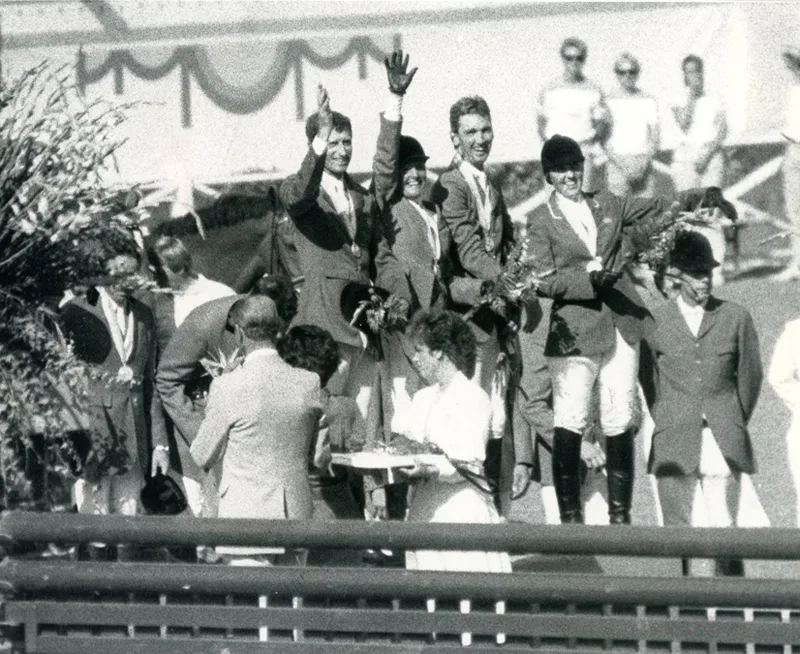
The 1984 team of (from left) Joe Fargis, Leslie Burr, Conrad Homfeld and Melanie Smith gave the U.S. show jumping its first Olympic team gold medal. John Strassburger Photos
Joe Fargis and Touch Of Class go clean in the lead-off spot. Leslie Burr and Albany, winners of two selection trials, pull one rail for 4 faults, Conrad Homfeld and Abdullah pull two rails for 8, and Melanie Smith and Calypso go clear. After one round the U.S. has a 4-fault total to 20 for Germany and 21.5 for Spain.
Fargis and the little bay mare come through with another faultless performance before Burr and Albany pull two. Homfeld and Abdullah nail down the U.S. win with a beautiful, faultless trip. Only three riders have gone, but the U.S. cannot be beaten, so Smith doesn’t have to jump again.
“It wasn’t that easy,” Smith said, referring to the course, “but I never thought I wouldn’t have to ride a second time. I felt like crying out there on the podium, but I was too excited!”
As the team marches to the victory stand on horseback, de Némethy stands in the middle of his creation. As the U.S. team passes by, Chapot embraces the former coach and bends down to give him a congratulatory kiss.
Click the link below to watch Conrad Homfeld and Abdullah’s final team round that secured the gold:
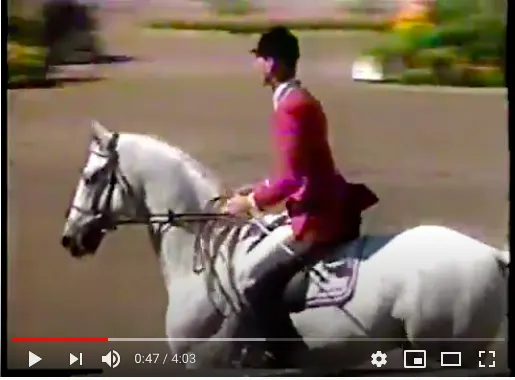 And if that’s not enough, cut to Sunday for individual jumping: A total of 50 riders start the first round on another de Némethy course. Only two go clean, and one is Joe Fargis on Touch of Class. Six have 4 faults, and one is Conrad Homfeld, Fargis’ longtime friend and partner at Sandron Farm in Petersburg, Va., and another is the third American rider, Melanie Smith on Calypso.
And if that’s not enough, cut to Sunday for individual jumping: A total of 50 riders start the first round on another de Némethy course. Only two go clean, and one is Joe Fargis on Touch of Class. Six have 4 faults, and one is Conrad Homfeld, Fargis’ longtime friend and partner at Sandron Farm in Petersburg, Va., and another is the third American rider, Melanie Smith on Calypso.
ADVERTISEMENT
In the second round—Smith has 8 faults, Homfeld goes clean, and Fargis pulls the last fence. Britain’s Michael Whitaker, 24 years old and tied for the lead, has a disaster at the triple combination and ends up 25th with 28.50 faults.
For the first time in Olympic history, it’s two Americans jumping off for the gold medal. Homfeld and the gray Trakehner stallion pull the second fence, but Fargis and the Thoroughbred mare have their fourth clean round in five tries to win the gold.
Would you buy this story?
A Test Of Champions
“The Americans made us look like fools. They were so good today it was impossible to beat them,” said West German anchor rider Paul Schockemöhle after the U.S. show jumping team defeated 14 teams to win their first Olympic team gold. The Americans won by so much (12 faults to 36.75 for Britain and 39.25 for Germany) that for the first time in Olympic history the final rider, Melanie Smith, didn’t have to do a second round.
The USET’s show jumping squad has been among the best in the world for some time, but never as awesome as in the last year. In 1983, they won four Nations Cups—including beating most of these teams at Rome and Calgary—and the Pan-Am Games, and put six riders in the top 10 at the FEI Volvo World Cup Finals. But the USET had never brought home the team gold, even in the halcyon days of Steinkraus, Chapot, Morris and [Hugh] Wiley under de Némethy’s coaching.
“I’ve been trying to win a gold medal for a long time,” said Chapot, who rode in six Olympics and brought home two team silvers. “This is my first time (to win) as a coach, except for the Pan-Am Games. This has meant a lot to me. I’ll remember it for a lot longer than the riders think they will.”
But Paul, weren’t the Americans at an advantage because their horses were more used to the heat and smog and because they had most of the crowd of 32,000 cheering for them? “I think it’s always an advantage to be at home, but I think they would have won anywhere,” Schockemöhle said.
Ronnie Massarella, the chef d’equipe of the surprising British team, agreed. “On this day they were a far better team. They were great, and you can’t take that away from them,” he said.
Three words can describe de Némethy’s Nations Cup course: creative varied and technical. It had a wide range of jump types—verticals, oxers, triple bars. Liverpools, open water each with a theme and built with fine craftsmanship. The entire course was adorned with more flowers, shrubs and greenery than can be found in the rest of southern California.
“From the comments of the other coaches, this was the best Olympic course they’ve ever seen,” said Chapot. “A lot of times it’s so big the small horses can’t get over it. But this course really tested the riders’ skill and preparation.”
ADVERTISEMENT
“I think it was a course designer’s dream,” said Leslie Burr. “Every fence had a least one rail down. There wasn’t a trap where you said, ‘Ah, ha. That’s what you have to get past.’ ”
More Than A Touch Of Class
For Fargis and Homfeld, 1984 has been the summit of parallel USET careers spanning 14 years. Fargis first rode for the team in 1970, helping to win the Nations Cup at Lucerne [Switzerland] on Bonte II, and Homfeld debuted in 1971, helping to win the Nations Cup at Aachen [Germany] on Triple Crown. Fargis was also a member of the winning team at the 1975 Pan-Am Games and on four winning Nations Cup teams last year, while Homfeld was the American Grandprix Association’s rider of the year in 1979 and 1980 and won the FEI Volvo World Cup Finals in 1980.
Still, both tended to downplay the importance of the Olympics, an outlook many members of the press, who were used to the exuberance of most other athletes, couldn’t understand. “It’s only a small time in the lifespan of a rider. The sun doesn’t rise and set on this moment,” said Homfeld before the start of competition, a theme he repeated when it was over. “It’s great, and I’m not about to give my medals back, but I don’t think they’re going to make a big change in my life. I think it will make the sport a little more popular, though, because an American won it and got second, and there were a lot of people watching.”
Touch Of Class has had a lot of people watching her during her 11 years. She was raised in Maryland by former flat jockey Jennifer Rowland Small, now a whipper-in and wife to Douglas R. Small, Sr., the huntsman and MFH of Elkridge-Harford Hunt. Touch Of Class, a half-sister to major timber winner Crocodile Fears, raced two years under her registered name Stillaspill, finishing off the board in each of her six starts. She then came into the hands of Maryland horsewoman Sylvia Hector, who sold Touch Of Class to Cyrene Loveland, who started her as a hunter. Touch Of Class was subsequently handled by Vince Dugan, Sally Dohner and Frances Rowe. Fargis says she didn’t do well as a hunter, but “every time she was asked to jump higher and wider, she rose to the occasion pleasantly and willingly.” So her jumper career began.
Click the link below to watch Joe Fargis and Conrad Homfeld battle for individual gold, with Bill Steinkraus commentary:
Touch of Class won her first AGA grand prix in 1982, when Conrad Homfeld won the I Love New York Grand Prix on her. But Fargis never won with her until this year, when they won the Mercedes Grand Prix of Florida in March, the Grand Prix of Cincinnati in June, and now the Olympics.
Fargis didn’t think there was an explanation for her sudden rash of victories. “There’s no difference. The horse is going about the same for me,” he said. “The mare has always gone nicely, coming in second or third, but recently the circumstances have changed—other horses have been pulling rails. There’s nothing mystical about it.”
There really was something almost mystical about the unprecedented American success at these Olympics. The horses and riders were awesome, totally in a class by themselves, turning in one brilliant round after another. On Sunday afternoon. Bert de Némethy stood along in the middle of his course. A very proud moment had just passed—Americans had won over his demanding courses as they never had before—and he looked as if he wanted to savor it.
“They rode the best, and this is not the first time,” he said. “I am very, very happy because I thought there would be very few clean rounds in these Olympics. My approach is and was with the team to teach them the fundamentals, to teach them to control and influence their horses.”
Fargis, Homfeld and Chapot walked back into the ring. Each gave de Némethy a heart-felt embrace in turn. “Thank you, Bert, thank you for everything,” said Fargis.


